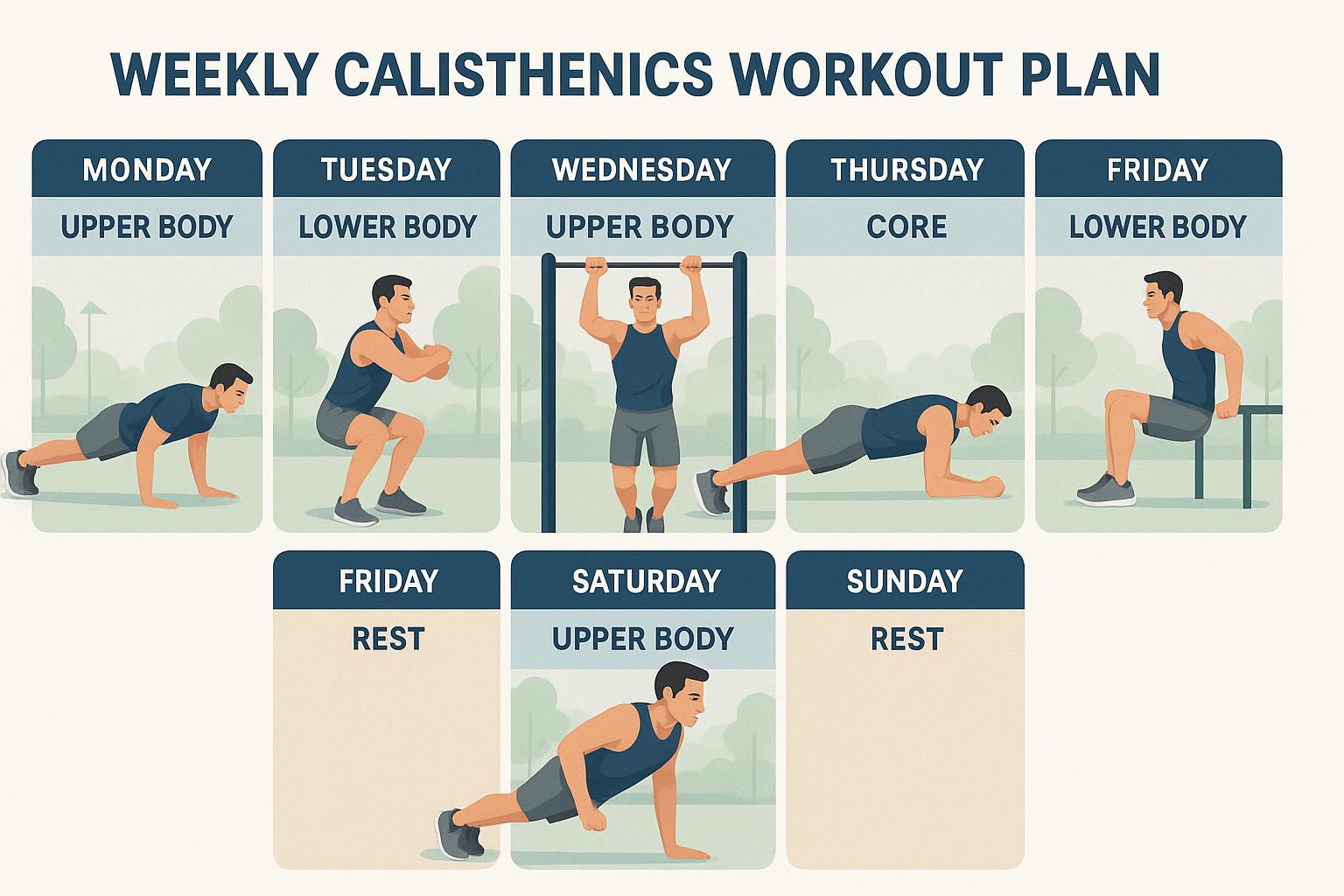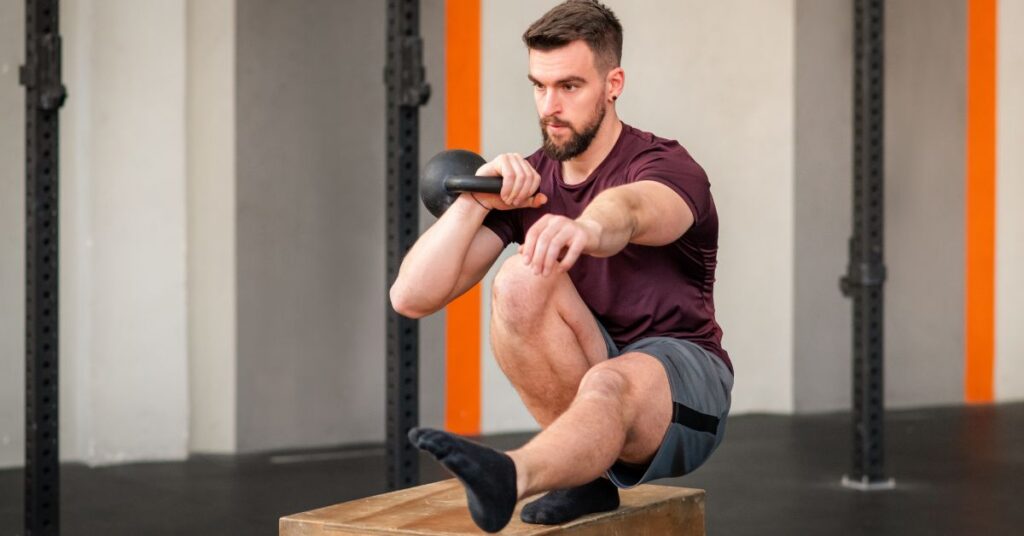20 Best Calisthenics Workout Plan Exercises are: Push-ups for upper body strength, Pull-ups for back and biceps, Squats for lower body, Planks for core stability, Dips for triceps and chest, Lunges for legs and glutes, Mountain Climbers for cardio and core, Burpees for full-body conditioning, Leg Raises for lower abs, Pike Push-ups for shoulders, Crunches for upper abs, Inverted Rows for pulling strength, Jumping Rope for cardio, Side Plank Reach for obliques, High Knees for heart rate, Jumping Jacks for total body movement, Reverse Cross Lunge for balance, Wall Sit for endurance, Bear Crawl for coordination, Glute Bridges for posterior chain.
Calisthenics workout plan is rapidly gaining popularity in the fitness community as an effective way to build strength, enhance mobility, and improve overall body control. If you’re seeking a dynamic and efficient approach to training using your own body weight, a calisthenics workout plan could be your ideal solution. This comprehensive guide will equip you with essential insights on creating and executing a successful calisthenics workout plan, while also showing you how to effectively integrate a calisthenic and weight training workout plan for optimal results.
Table of Contents
20 Best Calisthenics Workout Plan
These ten fundamental calisthenic exercises form the cornerstone of any effective bodyweight training program, targeting every major muscle group while building functional strength. Each movement can be modified for beginners or advanced to challenge experienced practitioners. Mastering these exercises provides the foundation for more complex skills and comprehensive fitness development.
Calisthenics Workout Plan: Overview Table
| Sr.No. | Exercise | Primary Muscles | Difficulty Level | Equipment Needed |
|---|---|---|---|---|
| 1 | Push-ups | Chest, Shoulders, Triceps | Beginner-Advanced | None |
| 2 | Pull-ups | Back, Biceps, Forearms | Intermediate-Advanced | Pull-up Bar |
| 3 | Squats | Quads, Glutes, Calves | Beginner-Advanced | None |
| 4 | Planks | Core, Shoulders, Glutes | Beginner-Intermediate | None |
| 5 | Dips | Chest, Triceps, Shoulders | Intermediate-Advanced | Parallel Bars/Chair |
| 6 | Lunges | Quads, Glutes, Hamstrings | Beginner-Intermediate | None |
| 7 | Mountain Climbers | Core, Cardio, Full Body | Beginner-Intermediate | None |
| 8 | Burpees | Full Body, Cardio | Intermediate-Advanced | None |
| 9 | Leg Raises | Lower Abs, Hip Flexors | Beginner-Intermediate | None |
| 10 | Pike Push-ups | Shoulders, Triceps, Core | Intermediate-Advanced | None |
| 11 | Crunches | Upper Abs, Core | Beginner | None |
| 12 | Inverted Rows | Back, Biceps, Rear Delts | Beginner-Intermediate | Bar/Table |
| 13 | Jumping Rope | Cardio, Calves, Coordination | Beginner-Advanced | Jump Rope |
| 14 | Alternating Side Plank Reach | Core, Obliques, Shoulders | Intermediate | None |
| 15 | High Knees | Cardio, Hip Flexors, Core | Beginner | None |
| 16 | Jumping Jacks | Full Body, Cardio | Beginner | None |
| 17 | Reverse Cross Lunge | Glutes, Quads, Balance | Intermediate | None |
| 18 | Wall Sit | Quads, Glutes, Endurance | Beginner-Intermediate | Wall |
| 19 | Bear Crawl | Full Body, Core, Shoulders | Intermediate | None |
| 20 | Glute Bridges | Glutes, Hamstrings, Core | Beginner | None |
Build lean muscle naturally with bodyweight exercises.

Master explosive form and maximize power with the proper technique: how to do jump squats
Calisthenics Workout Plan: Detailed Exercise Instructions
1. Push-ups
The quintessential upper body exercise that builds chest, shoulder, and tricep strength while engaging core stabilizers. This foundational movement develops functional pushing power essential for daily activities and advanced calisthenics skills. Master proper form before progressing to challenging variations like diamond, archer, or single-arm push-ups.
How to Do Push-ups?
- Start in plank position with hands slightly wider than shoulder-width apart
- Keep body in straight line from head to heels, core engaged throughout
- Lower chest toward ground by bending elbows, keeping them at 45-degree angle
- Descend until chest nearly touches floor or comfortable depth
- Push through palms to return to starting position with control
- Maintain neutral neck position, avoid looking up or dropping head
- Breathe in on descent, exhale on push-up phase
2. Pull-ups
The ultimate back and bicep builder that develops functional pulling strength essential for climbing and lifting movements. This challenging exercise strengthens the entire posterior chain while improving grip strength and lat development. Progress systematically from assisted variations to advanced movements like archer or weighted pull-ups.
How to Do Pull-ups?
- Hang from pull-up bar with overhand grip, hands shoulder-width apart
- Engage core and maintain slight hollow body position
- Pull body up by driving elbows down and back toward ribs
- Continue until chin clears the bar completely
- Lower with control to full arm extension without swinging
- Keep shoulders away from ears throughout movement
- Focus on squeezing back muscles at top position
3. Squats
The foundational lower body movement that strengthens quadriceps, glutes, and calves while improving hip mobility and functional movement patterns. This essential exercise mimics daily activities like sitting and standing, making it crucial for maintaining mobility and strength. Progress from bodyweight to single-leg variations for advanced challenges.
How to Do Squats?
- Stand with feet shoulder-width apart, toes slightly pointed outward
- Keep chest up and maintain natural spine curvature throughout
- Lower by pushing hips back and bending knees simultaneously
- Descend until thighs are parallel to ground or comfortable depth
- Keep knees tracking over toes, avoid inward collapse
- Push through heels to return to standing position
- Maintain even weight distribution across both feet
4. Planks
The core stability champion that builds deep abdominal strength, shoulder stability, and full-body tension. This isometric exercise develops endurance in postural muscles while teaching proper spine alignment and breathing under tension. Progress from knee planks to advanced variations like single-limb planks for comprehensive core development.
How to Do Planks?
- Start in forearm plank position with elbows under shoulders
- Keep body in straight line from head to heels, no sagging or piking
- Engage core by pulling belly button toward spine
- Maintain neutral neck position, eyes looking down at floor
- Breathe normally while holding static position
- Keep glutes and legs engaged to maintain proper alignment
- Hold for prescribed time while maintaining perfect form
5. Dips
The powerful pushing exercise that targets chest, triceps, and shoulders through a different angle than push-ups. This versatile movement can be performed on parallel bars, chairs, or benches, making it accessible for various fitness levels. Progress from assisted dips to weighted variations for continued strength development.
How to Do Dips?
- Position hands on parallel bars or chair edges, supporting body weight
- Keep shoulders over wrists and maintain upright torso position
- Lower body by bending elbows straight back, not flaring outward
- Descend until shoulders are slightly below elbow level
- Push through palms to return to starting position with control
- Keep legs straight or slightly bent throughout movement
- Avoid excessive forward lean to prevent shoulder strain
6. Lunges
The unilateral leg strengthener that builds quadriceps, glutes, and hamstrings while challenging balance and coordination. This functional movement pattern translates directly to walking, running, and climbing activities. Progress from stationary lunges to dynamic variations like walking lunges or jump lunges for increased difficulty.
How to Do Lunges?
- Stand upright with feet hip-width apart, hands on hips or sides
- Step forward with one leg, maintaining upright torso position
- Lower body until both knees form 90-degree angles
- Keep front knee directly over ankle, back knee hovering above ground
- Push through front heel to return to starting position
- Alternate legs or complete all reps on one side before switching
- Maintain balance and control throughout entire movement
7. Mountain Climbers
The dynamic cardio-strength combination that elevates heart rate while strengthening core, shoulders, and legs. This high-intensity exercise improves cardiovascular fitness while building muscular endurance and coordination. Start with controlled movements and gradually increase pace for maximum cardiovascular and strength benefits.
How to Do Mountain Climbers?
- Start in high plank position with hands under shoulders
- Keep core engaged and body in straight line throughout
- Drive right knee toward chest while keeping left leg extended
- Quickly switch legs, bringing left knee to chest as right extends
- Continue alternating legs in running motion while maintaining plank
- Keep hips level and avoid bouncing up and down
- Maintain steady breathing rhythm despite increased intensity
8. Burpees
The ultimate full-body conditioning exercise that combines strength, cardio, and coordination in one demanding movement. This challenging exercise works every major muscle group while providing intense cardiovascular training. Master the basic pattern before advancing to variations like burpee box jumps or single-leg burpees.
How to Do Burpees?
- Start standing with feet shoulder-width apart, arms at sides
- Squat down and place hands on floor in front of feet
- Jump or step feet back into high plank position
- Perform one push-up with proper form and control
- Jump or step feet back toward hands into squat position
- Explosively jump up with arms reaching overhead
- Land softly and immediately begin next repetition
9. Leg Raises
The targeted abdominal exercise that strengthens lower abs and hip flexors while improving core control and stability. This isolation movement specifically targets the often-neglected lower portion of the rectus abdominis. Progress from bent-knee variations to straight-leg raises and eventually hanging leg raises for maximum challenge.
How to Do Leg Raises?
- Lie on back with legs extended, hands at sides or under lower back
- Keep lower back pressed against floor throughout movement
- Raise legs up until they form 90-degree angle with torso
- Keep legs straight or slightly bent depending on flexibility
- Lower legs with control, stopping just before feet touch ground
- Maintain constant tension in abdominal muscles throughout
- Avoid using momentum or swinging legs during movement
10. Pike Push-ups
The shoulder-focused pushing exercise that builds deltoid strength and prepares you for advanced skills like handstand push-ups. This inverted movement pattern develops pressing strength in a different plane while improving shoulder mobility and stability. Progress from elevated feet to wall-supported handstand variations for ultimate development.
How to Do Pike Push-ups?
- Start in downward dog position with hands shoulder-width apart
- Walk feet closer to hands to increase pike angle
- Keep legs straight and weight distributed between hands and feet
- Lower head toward hands by bending elbows forward
- Keep elbows pointing forward, not flaring to sides
- Press back to starting position using shoulder and arm strength
- Maintain pike position throughout entire movement range
11. Crunches
The classic abdominal exercise that specifically targets the rectus abdominis while teaching proper spinal flexion patterns. This fundamental core movement builds upper abdominal strength and endurance while being accessible to all fitness levels. Focus on quality over quantity, emphasizing controlled movement and proper breathing patterns throughout each repetition.
How to Do Crunches?
- Lie on back with knees bent, feet flat on floor
- Place hands behind head lightly, avoid pulling on neck
- Engage core by pulling belly button toward spine
- Lift shoulders and upper back off ground using abdominal muscles
- Keep lower back pressed against floor throughout movement
- Lower with control back to starting position
- Exhale during lifting phase, inhale during lowering phase
12. Inverted Rows
The horizontal pulling exercise that strengthens the back, biceps, and rear deltoids while serving as an excellent pull-up progression. This movement balances out pushing exercises and improves posture by strengthening the often-weak posterior chain muscles. Adjust body angle to modify difficulty level appropriately.
How to Do Inverted Rows?
- Position yourself under a bar or table at chest height
- Grab bar with overhand grip, hands shoulder-width apart
- Keep body in straight line from head to heels
- Pull chest toward bar by driving elbows back and down
- Squeeze shoulder blades together at top position
- Lower with control back to starting position
- Keep core engaged and avoid sagging hips throughout
13. Jumping Rope
The cardiovascular exercise that improves coordination, agility, and lower leg strength while burning significant calories. This rhythmic movement enhances footwork, timing, and cardiovascular endurance essential for many sports and activities. Start with basic jumps and progress to advanced footwork patterns and speed variations.
How to Do Jumping Rope?
- Hold rope handles with relaxed grip, elbows close to sides
- Position rope behind feet to start, arms forming gentle arc
- Rotate rope using wrist action, not large arm movements
- Jump just high enough for rope to pass under feet
- Land softly on balls of feet, maintaining light contact with ground
- Keep knees slightly bent and core engaged throughout
- Maintain steady rhythm and breathing pattern during exercise
14. Alternating Side Plank Reach
The dynamic core exercise that challenges obliques, shoulders, and coordination through rotational movement patterns. This advanced plank variation builds lateral core strength while improving stability and control through multiple planes of motion. Master basic side planks before attempting this challenging rotational variation.
How to Do Alternating Side Plank Reach?
- Start in standard plank position with arms extended
- Rotate into side plank, supporting weight on one arm
- Reach top arm under body and toward opposite side
- Return top arm to vertical position while maintaining side plank
- Rotate back to center plank, then repeat on opposite side
- Keep hips elevated and core engaged throughout movement
- Control rotation speed and maintain proper alignment
15. High Knees
The dynamic cardiovascular exercise that elevates heart rate while strengthening hip flexors and improving leg turnover. This high-intensity movement mimics running mechanics while being performed in place, making it perfect for warm-ups or cardio intervals. Focus on proper posture and controlled breathing throughout.
How to Do High Knees?
- Stand tall with feet hip-width apart, arms at sides
- Maintain upright posture with chest up and core engaged
- Drive right knee up toward chest while pumping left arm
- Quickly switch, bringing left knee up as right leg lowers
- Continue alternating legs in rapid running motion
- Aim to bring knees to hip level or higher if possible
- Land softly on balls of feet between each knee drive
16. Jumping Jacks
The full-body cardiovascular exercise that coordinates arm and leg movements while elevating heart rate significantly. This classic calisthenics movement improves coordination, burns calories, and serves as an excellent warm-up or cardio finisher. Progress from basic jumping jacks to power jacks or cross-body variations for increased intensity.
How to Do Jumping Jacks?
- Start standing with feet together, arms at sides
- Jump feet apart to shoulder-width while raising arms overhead
- Jump feet back together while lowering arms to sides
- Maintain upright posture and soft landings throughout
- Keep core engaged and avoid excessive forward lean
- Coordinate arm and leg movements in smooth, rhythmic pattern
- Land softly on balls of feet to minimize impact
17. Reverse Cross Lunge
The multidirectional leg exercise that targets glutes, quadriceps, and stabilizer muscles while challenging balance and coordination. This complex movement pattern combines backward and lateral movement, improving functional strength and mobility. Master basic lunges before progressing to this more challenging variation.
How to Do Reverse Cross Lunge?
- Start standing with feet hip-width apart, hands on hips
- Step left foot back and across behind right leg
- Lower into lunge position with both knees bent
- Keep most weight on front leg, back toe touching ground
- Push through front heel to return to starting position
- Complete all reps on one side before switching legs
- Maintain upright torso and controlled movement throughout
18. Wall Sit
The isometric leg exercise that builds quadriceps endurance while strengthening glutes and improving lower body stamina. This challenging static hold teaches proper squat mechanics while developing mental toughness and muscular endurance. Progress by increasing hold time or adding single-leg variations for advanced challenges.
How to Do Wall Sit?
- Stand with back against wall, feet shoulder-width apart
- Slide down wall until thighs are parallel to ground
- Keep knees at 90-degree angles, directly over ankles
- Maintain back contact with wall throughout hold
- Keep weight evenly distributed across both feet
- Hold position for prescribed time while breathing normally
- Focus on keeping core engaged and chest up
19. Bear Crawl
The full-body exercise that strengthens core, shoulders, and legs while improving coordination and stability. This primal movement pattern challenges multiple muscle groups simultaneously while developing functional strength patterns. Start with short distances and focus on maintaining proper form before increasing speed or distance.
How to Do Bear Crawl?
- Start on hands and knees with wrists under shoulders
- Lift knees 2-3 inches off ground, balancing on hands and toes
- Keep back flat and core engaged throughout movement
- Move forward by advancing opposite hand and foot simultaneously
- Take small, controlled steps maintaining low position
- Keep hips level and avoid swaying side to side
- Maintain steady breathing despite challenging position
20. Glute Bridges
The posterior chain exercise that strengthens glutes and hamstrings while improving hip extension patterns. This fundamental movement corrects common posture issues caused by prolonged sitting and builds strength essential for squats and deadlifts. Progress from double-leg to single-leg variations for increased difficulty and unilateral strength.
How to Do Glute Bridges?
- Avoid overarching back or using momentum during movement
- Lie on back with knees bent, feet flat on floor
- Keep arms at sides for stability and support
- Squeeze glutes and push through heels to lift hips
- Create straight line from knees to shoulders at top
- Hold briefly at top while squeezing glutes maximally
- Lower hips with control back to starting position
These powerful compound dumbbell exercises hit multiple muscles at once for efficient strength gains.

What Is Calisthenics and Why Is a Calisthenics Workout Plan Important?
Calisthenics derives from the Greek words “kalos” (beauty) and “sthenos” (strength), representing a training philosophy that emphasizes graceful, controlled bodyweight movements. This ancient practice has evolved into a modern fitness methodology that builds functional strength, enhances mobility, and develops remarkable body control through progressive skill acquisition. Unlike traditional weightlifting, calisthenics uses your own body as resistance, creating movements that translate directly to real-world activities and athletic performance.
A structured calisthenics workout plan provides the roadmap for systematic progress, ensuring balanced muscle development while preventing plateaus and injuries. Without proper planning, random exercise selection often leads to muscle imbalances, stalled progress, and frustration. A well-designed plan incorporates progressive overload principles, adequate recovery periods, and skill-building sequences that transform beginners into advanced practitioners capable of performing impressive feats of strength, balance, and coordination that showcase the true artistry of human movement.
Know the difference: Push-ups vs Bench Press-which one wins for strength?

Calisthenics Workout Plan Essentials at a Glance
Understanding the core components of effective calisthenics programming helps you create a balanced, progressive training approach. This quick-reference guide summarizes the essential elements including training focus areas, exercise categories, optimal weekly structure, and proven progression methods. These fundamentals ensure your workout plan delivers consistent results while maintaining proper balance between challenge and recovery.
| Training Focus | Exercise Categories | Weekly Structure | Progression Methods |
|---|---|---|---|
| Upper Body: Push-ups, Pull-ups, Dips | Bodyweight: No equipment needed | 3-4 Days: Training frequency | Reps: Increase repetitions |
| Lower Body: Squats, Lunges, Bridges | Functional: Real-world strength | 1-2 Days: Rest and recovery | Variations: Advanced movements |
| Core: Planks, Leg raises, Twists | Scalable: All fitness levels | Flexibility: Adaptable schedule | Time: Reduce rest periods |
| Full Body: Compound movements | Progressive: Continuous improvement | Hybrid: Mix with weights optional | Intensity: Increase difficulty |
Here’s how to get a six pack quick with smart workouts and fat-burning strategies

Why Choose a Calisthenics Workout Plan?
The beauty of a well-structured calisthenics workout plan lies in its simplicity and scalability. Whether you’re a complete beginner or an advanced athlete, bodyweight exercises can be modified to match your current abilities while providing a clear progression path toward more challenging movements and greater strength gains.
Understanding the benefits of a calisthenics workout plan helps explain why this training method has become increasingly popular among fitness enthusiasts, athletes, and everyday people seeking effective exercise solutions.
Try this effective calisthenics core workout for stability, control, and visible abs.

The Best Calisthenics Workout Plan – Goals
Establishing clear, specific goals transforms your calisthenics journey from random exercise sessions into purposeful training with measurable outcomes. Whether focusing on strength, skill acquisition, or physique development, well-defined objectives provide direction and motivation throughout your fitness evolution. These goals should be challenging yet achievable, creating stepping stones toward long-term success.
- Strength Development: Build functional pushing, pulling, and core strength through progressive bodyweight exercises
- Skill Mastery: Learn advanced movements like handstands, muscle-ups, and human flags
- Muscle Growth: Develop lean muscle mass and improve body composition through high-volume training
- Endurance Enhancement: Increase muscular and cardiovascular endurance through circuit-style workouts
- Flexibility Improvement: Enhance mobility and range of motion through dynamic movement patterns
- Body Control: Develop proprioception, balance, and spatial awareness for athletic performance
- Injury Prevention: Strengthen stabilizing muscles and correct movement imbalances
- Mental Discipline: Build focus, determination, and confidence through challenging skill progressions
Discover the best workout to lose weight and gain muscle and transform your body faster.
Calisthenics Workout Plan vs. Weight Training
Comparing a calisthenics workout plan with traditional weight training helps you understand how these approaches complement each other and when each method might be most beneficial for your fitness goals. Regardless of your chosen training approach, proper nutrition timing through strategies like an intermittent fasting plan can enhance your results by optimizing recovery and body composition alongside your exercise routine.
| Aspect | Calisthenics | Weight Training |
| Resistance Source | Bodyweight movements like push-ups, pull-ups, and squats | External loads using dumbbells, barbells, and machines |
| Skill Development | Enhances body awareness, coordination, and agility | Focuses primarily on strength and muscle development |
| Movement Patterns | Mimics natural human movement patterns and functional activities | Can isolate specific muscle groups with targeted exercises |
| Progress Tracking | Advances through exercise variations and skill progressions | Easy to quantify through measurable weight increases |
| Strength Building | Builds functional strength and muscular endurance | Often superior for developing maximum absolute strength |
| Equipment Requirements | Minimal to no equipment needed, highly accessible | Requires gym access or substantial equipment investment |
| Space Requirements | Can be performed anywhere with minimal space | Typically requires dedicated gym or home gym setup |
| Learning Curve | Requires technique mastery for advanced progressions | More straightforward progression through weight addition |
| Injury Risk | Lower risk due to natural movement patterns | Moderate risk, especially with heavy loads and poor form |
| Cost Effectiveness | Extremely cost-effective, no ongoing expenses | Requires gym memberships or equipment purchases |
Start your journey with a gentle, effective full-body routine: burpee workout for beginners
Creating Your Structured Calisthenics Workout Plan
A structured calisthenics workout plan is essential for building strength, improving endurance, and avoiding plateaus. By organizing your weekly schedule with targeted upper body, lower body, and core sessions, you ensure balanced progress and adequate recovery time. Don’t overlook specialized areas like forearm calisthenics which play a crucial role in supporting advanced movements and preventing weak points in your overall development.
Planning Principles:
- Balanced Development: Include all major movement patterns
- Progressive Structure: Gradually increase difficulty over time
- Recovery Integration: Allow adequate rest between training sessions
- Individual Adaptation: Customize based on your fitness level and goals
Learn how to do dumbbell bench press with proper form for chest gains

Creating Your Calisthenics Training Plan
A structured calisthenics workout plan is essential for building strength, improving endurance, and avoiding plateaus. By organizing your weekly schedule with targeted upper body, lower body, and core workouts, you ensure balanced progress and recovery. Whether you’re a beginner or aiming to level up, a customized plan keeps your training efficient and effective. For detailed guidance, check out Calisthenics Exercises.
Sample Weekly Calisthenics Workout Plan
| Day | Focus | Main Exercises | Sets × Reps |
| Day 1 | Upper Body | Push-ups, Pull-ups, Dips | 3 × 8-15 |
| Day 2 | Lower Body | Squats, Lunges, Bridges | 3 × 10-20 |
| Day 3 | Core | Planks, Leg Raises, Twists | 3 × 10-60sec |
| Day 4 | Recovery | Stretching, Light Activity | 20-30 min |
Discover the ideal daily count that balances strength and recovery for core results: how many crunches per day for abs
Calisthenics Workout Plan: Requirements
Success in calisthenics depends on meeting specific fundamental requirements that create the foundation for safe, effective training. These prerequisites ensure you can progress systematically while minimizing injury risk and maximizing results. Understanding and implementing these requirements sets you up for long-term success in your bodyweight training journey.
- Consistency: Commit to regular training sessions (3-4 times per week minimum)
- Progressive Overload: Gradually increase difficulty through reps, variations, or reduced rest
- Proper Form: Master basic movement patterns before advancing to complex exercises
- Adequate Recovery: Allow 48-72 hours between training the same muscle groups
- Balanced Programming: Include pushing, pulling, squatting, and core movements equally
- Patience: Accept that skill-based progressions take time and consistent practice
- Basic Equipment: Access to a pull-up bar (parallel bars optional but recommended)
- Safe Training Space: Clear area with adequate ceiling height and non-slip flooring
- Warm-up Protocol: Prepare your body with dynamic movements before training
- Nutrition Support: Maintain adequate protein and calorie intake for recovery and growth
Target your arms with this effective resistance band bicep workout.
Customizing Your Calisthenics Workout Plan
The key to a successful calisthenics workout plan is customization based on your individual fitness level, goals, and available time. Everyone progresses at different rates, so adjusting your program ensures continued improvement and prevents plateaus.
Beginner Modifications:
- Knee Push-ups: Instead of standard push-ups
- Assisted Pull-ups: Using resistance bands or assistance
- Box Step-ups: As progression toward full lunges
- Incline Push-ups: Using elevated hand position
Advanced Progressions:
- Archer Push-ups: Single-arm emphasis variations
- Muscle-ups: Combining pull-up and dip movements
- Handstand Push-ups: Inverted pressing movements
- Pistol Squats: Single-leg squat variations
Time-Based Adjustments:
- 30-Minute Sessions: Focus on compound movements
- 15-Minute Quick Workouts: High-intensity circuit training
- 60-Minute Comprehensive: Include warm-up, main workout, and cool-down
Strengthen your posterior chain with these essential back calisthenics exercises.

Calisthenics Workout Plan for Beginners
Starting your calisthenics journey requires a foundation-focused approach that builds basic strength while teaching proper movement patterns. This beginner plan emphasizes mastering fundamental exercises with perfect form rather than attempting advanced variations. Each exercise can be modified to match your current ability level, ensuring safe progression toward more challenging movements.
| Exercise | Sets × Reps | Modification | Focus |
| Knee Push-ups | 2 × 5-10 | Wall push-ups if needed | Upper body strength |
| Assisted Squats | 2 × 8-12 | Use chair for support | Lower body foundation |
| Plank Hold | 2 × 15-30 sec | Knee plank variation | Core stability |
| Glute Bridges | 2 × 8-12 | Single or double leg | Hip strength |
Get the right dose for intensity without burnout: how many burpees a day
Calisthenics Workout Plan for Advanced Athletes
Advanced calisthenics training demands exceptional strength, skill, and body control developed through years of consistent practice. This level focuses on complex movement patterns, unilateral exercises, and skill-based challenges that push the boundaries of human performance. Advanced practitioners combine strength with artistry, creating fluid movement sequences that demonstrate mastery.
| Exercise | Sets × Reps | Progression | Focus |
| One-Arm Push-ups | 3 × 3-8 | Archer push-up prep | Unilateral strength |
| Muscle-ups | 3 × 3-8 | False grip training | Explosive power |
| Handstand Push-ups | 3 × 5-12 | Wall-assisted | Shoulder strength |
| Pistol Squats | 3 × 5-10 per leg | Box pistol squats | Single-leg power |
25-Minute Calisthenics Workout Plan
Time-efficient training becomes essential for busy lifestyles, making this 25-minute plan perfect for maintaining fitness consistency without lengthy gym sessions. This high-intensity format combines strength training with cardiovascular conditioning, maximizing results in minimal time. The structured timing ensures you complete a comprehensive full-body workout that fits any schedule.
| Phase | Exercises | Duration | Rest |
| Warm-up | Arm circles, leg swings, jumping jacks | 5 minutes | Active movement |
| Circuit 1 | Push-ups, squats, mountain climbers | 6 minutes | 30s work, 15s rest |
| Circuit 2 | Pull-ups, lunges, planks | 6 minutes | 30s work, 15s rest |
| Circuit 3 | Burpees, dips, leg raises | 6 minutes | 30s work, 15s rest |
| Cool-down | Static stretching, deep breathing | 2 minutes | Relaxation |
Combining Calisthenics with Weight Training
For those looking to maximize results, combining a calisthenics workout plan with traditional weight training offers comprehensive fitness development. This hybrid approach builds foundational strength through lifting while enhancing control, endurance, and mobility with bodyweight exercises. Incorporating specialized movements like forearm calisthenics into your routine ensures comprehensive upper body development and improved grip strength for advanced exercises.
Benefits of Hybrid Training:
- Increased Muscle Engagement: Weight training builds strength for advanced calisthenics movements
- Diverse Workouts: Alternating methods prevents boredom and overuse
- Enhanced Recovery: Bodyweight exercises provide active recovery on lighter weight days
- Skill Transfer: Strength gains from weights improve calisthenics performance
Sample Hybrid Weekly Schedule:
- Day 1: Weight training (Compound lifts)
- Day 2: Calisthenics (Upper body focus)
- Day 3: Rest or light cardio
- Day 4: Weight training (Isolation work)
- Day 5: Calisthenics (Full body circuit)
- Day 6: Active recovery
- Day 7: Complete rest

Mastering Progressive Overload in Calisthenics
To keep progressing with your calisthenics workout plan, applying the principle of progressive overload is key. By gradually increasing the intensity of your workouts—through reps, variations, or shorter rest—you can continually build strength, endurance, and muscle control over time.
What is Progressive Overload?
Progressive overload is the gradual increase of stress placed upon the body during exercise training in a calisthenics workout plan. To continue making gains in strength and muscle size with calisthenics, it’s essential to apply this principle.
Strategies for Implementing Progressive Overload
- Increasing Repetitions: Gradually add more reps to each set as you get stronger. For example, if you can perform 10 push-ups comfortably, aim for 12-15 in your next calisthenics and weight training workout plan.
- Adding Variations: Progress to more challenging exercise variations (e.g., from knee push-ups to standard push-ups, and eventually to archer push-ups).
- Reducing Rest Time: Decrease rest intervals between sets to increase the intensity of your workouts.
Tracking Your Progress: Tools and Techniques
Utilizing fitness apps and wearable technology can help you monitor your progress and stay motivated. Consider tracking your reps, sets, and exercise duration in calisthenics and weight training workout plan. Setting realistic goals and celebrating milestones can further enhance your commitment to your calisthenics workout plan.

Nutrition for Your Calisthenics Workout Plan
A well-rounded nutrition plan is crucial for supporting your calisthenics workout plan and maximizing results. Proper nutrition enhances performance, aids recovery, and helps you achieve your body composition goals.
Essential Macronutrients:
1. Protein for Muscle Recovery:
- Daily Target: 0.8-1.2 grams per pound of body weight
- Quality Sources: Chicken, fish, eggs, legumes, dairy products
- Timing: Include protein within 2 hours post-workout
- Plant Options: Quinoa, lentils, hemp seeds, spirulina
2. Carbohydrates for Energy:
- Complex Carbs: Brown rice, quinoa, oats, sweet potatoes
- Simple Carbs: Fruits for quick energy and recovery
- Timing: Consume carbs before and after workouts
- Fiber: Vegetables provide micronutrients and digestive health
3. Healthy Fats for Hormone Production:
- Sources: Avocados, nuts, seeds, olive oil, fatty fish
- Benefits: Support hormone production and reduce inflammation
- Moderation: 20-30% of total daily calories
Conclusion: Your Path to Mastering Calisthenics
Creating a calisthenics workout plan requires commitment, consistency, and a willingness to adapt as you progress. By integrating calisthenics with weight training, mastering progressive overload, and maintaining a balanced diet, you can unlock your potential and achieve your fitness goals.
Ready to take your calisthenics workout plan to the next level? At ISC – Indian School of Calisthenics, we provide expert coaching to help you build strength, mobility, and endurance through a personalized and progressive training approach. Visit us at SRPF Ground, NH8, Goregaon (E), Mumbai – 400065. For class schedules, personalized coaching, or more details, call +91 77159 53218. Train smart, move better, and unlock your back strength with ISC.
Calisthenics Workout Plan – FAQs
What is calisthenics?
Calisthenics refers to a form of exercise that leverages your body weight to enhance strength, flexibility, and endurance. It includes movements like push-ups, pull-ups, squats, and more. A well-structured calisthenics workout plan can help you achieve your fitness goals effectively.
How often should I train with calisthenics?
Aim for at least three to four training sessions per week, ensuring adequate rest and recovery between workouts. Following a consistent calisthenics workout plan will improve your results over time.
Can I combine calisthenics with weight training?
Yes! Integrating a calisthenics and weight training workout plan can significantly boost overall strength and muscle development. This combination enhances both body weight exercises and traditional strength training.
What equipment do I need for calisthenics and weight training workout plan?
You can start calisthenics with minimal equipment. However, using pull-up bars, gymnastic rings, or resistance bands can enhance your training experience and make your calisthenics workout plan more effective.
How can I track my progress in calisthenics and weight training workout plan?
Monitor your progress by logging your workouts, tracking your repetitions and sets, and utilizing fitness apps to establish goals and milestones. Keeping track of your calisthenics workout plan helps ensure you stay on target.
Is calisthenics suitable for beginners?
Yes, it’s beginner-friendly with scalable exercises that require little to no equipment.
How long does it take to see results from a calisthenics workout plan?
You may notice strength and endurance gains within 4–6 weeks with consistent training.
What muscles does calisthenics target?
It targets the entire body-chest, back, arms, legs, and especially the core.
Can calisthenics help with fat loss?
Yes, especially when combined with a calorie-controlled diet and regular workouts.
Do I need a personal trainer to follow a calisthenics workout plan?
Not necessarily. Many learn effectively through trusted online resources and self-discipline.


